Cezanne's
distinctive style, which imposed a new kind of order on nature, establishes him
as one of the founders of modern art. His painting reached maturity in the
1870s: the portrait of Madame Cezanne shows him simplifying and distorting her
image in the interests of artistic unity. Boy in a Red Waistcoat continues the
same trend.
Cezanne
was happiest painting people and places he knew well: the sturdy Provencal Card
Players, for example, and The Great Pine. He was less productive away from his
home ground, although paintings such as the Lake at Annecy bear his
unmistakable stamp. And he produced numerous works in his studio, where he was
free to organize the natural elements for still-life such as Apples and Oranges.
Around
the turn of the century, Cezanne's painting became freer, more fluid and even
more simplified. This can be seen in The Great Bathers and Mont
Sainte-Victoire, where his system of painting with patches of pure colour paves
the way for abstract art.
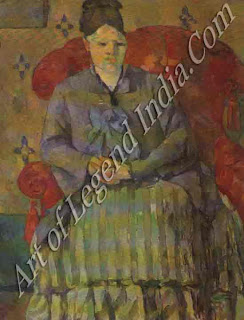 Painted
nine years before they married, Cezanne's portrait of Hortense is remarkably
impersonal. He was less concerned with revealing his mistress's character than
with the way the cool tones and flattened stripes of the dress are enveloped by
the warm pinks and rounded shapes of the armchair.
Painted
nine years before they married, Cezanne's portrait of Hortense is remarkably
impersonal. He was less concerned with revealing his mistress's character than
with the way the cool tones and flattened stripes of the dress are enveloped by
the warm pinks and rounded shapes of the armchair.
Although
he rarely used professional sitters, Cezanne made four oil portraits of this
young Italian model, Michelangelo di Rosa. The boy stands with hand on hip, in
the classic pose of the life-class nude, the curve of his body counterbalanced
by the swinging drapery.
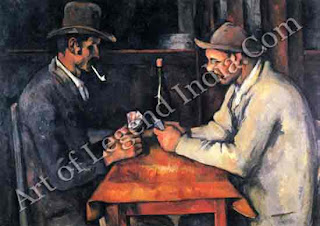
Cezanne's
paintings of local Provencal men quietly concentrating on a game of cards are
among his most popular works. He has stripped the scene to its bare essentials
two men facing each other across a table. Yet, quiet and provincial as it first
appears, this is a revolutionary painting. For the sake of artistic unity,
Cezanne has abandoned traditional perspective for example; the table appears
irregularly shaped as it is seen from several angles at once. Its top is tilted
forwards, while the men's bent knees appear flattened one above the other
against the front of the picture. And although the painting seems to be made up
of grays and browns, rough patches of blue, red and green, as well as areas of
bare canvas, give the picture a subtle vitality.
This
romantic image of a great tree buffeted by the forces of nature, yet rising
above them, originates from a poem which Cezanne wrote in his youth about 'The
tree shaken by the fury of the winds. The apparently simple composition,
centring on the tree's buckled trunk, evokes a powerful sense of tension.
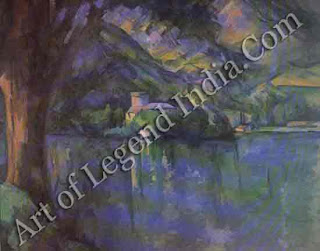 Cezanne
painted this alpine lake near the Swiss frontier to 'divert' himself during one
of the rare trips he made during his last years. Although he found the
mountainous scenery claustrophobic, he created a memorable image, particularly
striking because of the apparent solidity of the water.
Cezanne
painted this alpine lake near the Swiss frontier to 'divert' himself during one
of the rare trips he made during his last years. Although he found the
mountainous scenery claustrophobic, he created a memorable image, particularly
striking because of the apparent solidity of the water.
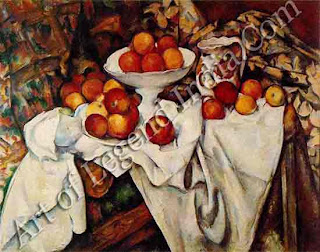 'This
is one of the most sumptuous of all Cezanne’s still-life. The complex arrangement
of fruit, dishes, jug out dreggy on a table which slops dramatically upwards from
the left is given, stability by the bold zigzag line created by the edges of
the white cloth. It was painting in Aix: some of the objects in the imbuing are
served there, in his Chemin des Lances mho.
'This
is one of the most sumptuous of all Cezanne’s still-life. The complex arrangement
of fruit, dishes, jug out dreggy on a table which slops dramatically upwards from
the left is given, stability by the bold zigzag line created by the edges of
the white cloth. It was painting in Aix: some of the objects in the imbuing are
served there, in his Chemin des Lances mho.
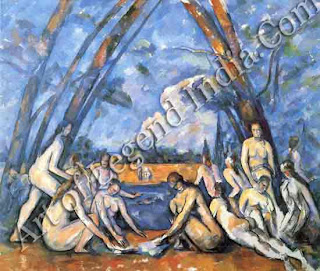 Nearly
seven feet high and over eight feet long, this is the largest of a late series
of paintings in which Cezanne attempted to integrate nude figures with
landscape. He achieved his aim: figures and landscape almost merge as the arch of the trees soars
up from the simplified curves of the wormer’s bodies.
Nearly
seven feet high and over eight feet long, this is the largest of a late series
of paintings in which Cezanne attempted to integrate nude figures with
landscape. He achieved his aim: figures and landscape almost merge as the arch of the trees soars
up from the simplified curves of the wormer’s bodies.
Cezanne
was obsessed with this huge limestone mountain, which stands some 10 miles from
Aix, and painted it over 60 times with increasing freedom. In this late work,
the sequence of fluid paint patches, which are used to suggest the natural
elements of the landscape, become an almost abstract mosaic of colour.
Writer
– Marshall Cavendish
 Painted
nine years before they married, Cezanne's portrait of Hortense is remarkably
impersonal. He was less concerned with revealing his mistress's character than
with the way the cool tones and flattened stripes of the dress are enveloped by
the warm pinks and rounded shapes of the armchair.
Painted
nine years before they married, Cezanne's portrait of Hortense is remarkably
impersonal. He was less concerned with revealing his mistress's character than
with the way the cool tones and flattened stripes of the dress are enveloped by
the warm pinks and rounded shapes of the armchair. Cezanne
painted this alpine lake near the Swiss frontier to 'divert' himself during one
of the rare trips he made during his last years. Although he found the
mountainous scenery claustrophobic, he created a memorable image, particularly
striking because of the apparent solidity of the water.
Cezanne
painted this alpine lake near the Swiss frontier to 'divert' himself during one
of the rare trips he made during his last years. Although he found the
mountainous scenery claustrophobic, he created a memorable image, particularly
striking because of the apparent solidity of the water. 'This
is one of the most sumptuous of all Cezanne’s still-life. The complex arrangement
of fruit, dishes, jug out dreggy on a table which slops dramatically upwards from
the left is given, stability by the bold zigzag line created by the edges of
the white cloth. It was painting in Aix: some of the objects in the imbuing are
served there, in his Chemin des Lances mho.
'This
is one of the most sumptuous of all Cezanne’s still-life. The complex arrangement
of fruit, dishes, jug out dreggy on a table which slops dramatically upwards from
the left is given, stability by the bold zigzag line created by the edges of
the white cloth. It was painting in Aix: some of the objects in the imbuing are
served there, in his Chemin des Lances mho. Nearly
seven feet high and over eight feet long, this is the largest of a late series
of paintings in which Cezanne attempted to integrate nude figures with
landscape. He achieved his aim: figures and landscape almost merge as the arch of the trees soars
up from the simplified curves of the wormer’s bodies.
Nearly
seven feet high and over eight feet long, this is the largest of a late series
of paintings in which Cezanne attempted to integrate nude figures with
landscape. He achieved his aim: figures and landscape almost merge as the arch of the trees soars
up from the simplified curves of the wormer’s bodies. 
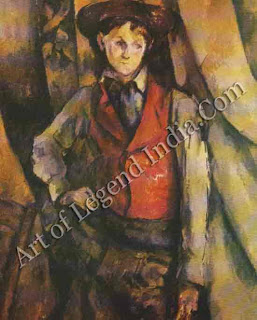

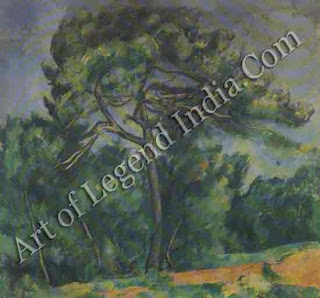
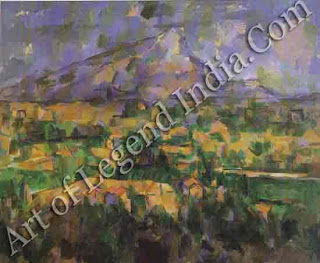










0 Response to "French Great Artist- P.C'ezanne Painting Gallery "
Post a Comment